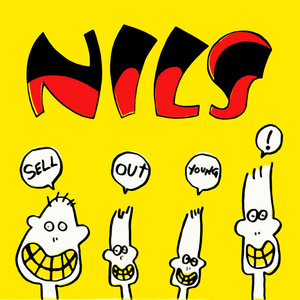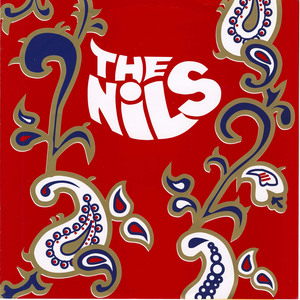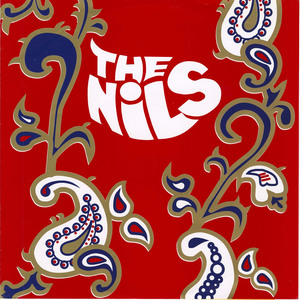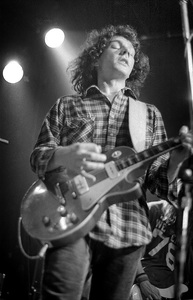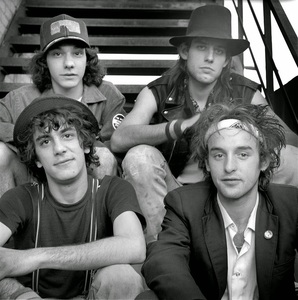Nils
Websites:
https://thenilsmtl.bandcamp.com/, https://www.facebook.com/TheNilsBand/
Origin:
Montréal, Québec
Biography:
When I first encountered The Nils, it came in the form of a nondescript, amateurish, primitive-looking, 300-copies Now cassette EP. They mailed it from Montreal in 1982 to my Manhattan bedroom/office for potential review in issue 12 of The Big Takeover. It looked slipshod, but their logo reminded me of west coast punk greats The Dils, so I shrugged and put it on out of due diligence. I hadn’t gotten 50 seconds into “Scratches and Needles” before I was pinned against my armchair in shock and excited awe, floored by their Who/Sex Pistols/Avengers roar, melodic might, and especially 16-year-old Alex Soria’s soaring mushmouth vocals. I ended up playing those five songs (see tracks 24-28 on their indispensable 1996 retrospective, Green Fields in Daylight) 100 times, raved about it that issue, and commenced a regular letters and phone correspondence with the band. I wanted to get them to New York.
Over the next five years, they only managed two compilation tracks (1984’s Something to Believe In, on L.A.’s BYO, and 1984’s Montreal punk scene sampler, Primitive Air Raid), then two vinyl EPs, 1985’s Sell Out Young and 1986’s prior-recorded Paisley. Both drew some notice, even if the latter was inexplicably limited to 500 copies and sold out quickly. And I extolled both in reviews in Big Takeover issues 20 and 22, and spun them regularly as a DJ on WNYU’s New Afternoon Show and for the big Rock Hotel New York punk shows—first at the Jane West Hotel, and eventually the 1500-capacity Ritz. Then one night, Rock Hotel boss/promoter Chris Williamson came into the DJ booth and asked for suggestions on whom else he might book. So I put on Sell Out Young’s “Daylight,” as he checked out its bright yellow sleeve. He clearly loved it, so I let “Fountains” play too, and he was sold. I gave him their contact info, and within a month, there was the group before us, playing in front of a giant Big Apple crowd and staying at my little flat. It felt good to help, and it cemented our friendship. It felt even better to see how great they were live. Alex, still only 20, turned out to be shockingly shy for all that fireball talent, barely even speaking. But he sang and played like a worried but determined little dog chasing a ball. His fellow guitarist/older brother Carlos was the opposite, a garrulous star, as charismatic in his extroversion as his sibling was in his intriguing introversion.
As it happened, Williamson was even more impressed by the gig, and he had started a label, Rock Hotel, a subsidiary of Profile Records that was selling boatloads of rap group Run-DMC, and had expanded into rock/hardcore like Cro-Mags’ Age of Quarrel in 1986. After five years of waiting, the Nils finally inked a deal, and to my delight, Williamson brought Alex, Carlos, bassist Guy “Chico” Caron and drummer Jean Lortie to New York to make the LP, produced by ’70s guitar hero Chris Spedding and engineer Phil Burnett. I found myself visiting them in Chunk King studios downtown on Varick Street, to witness what would prove their only proper album while Alex was alive.
When The Nils eventually appeared on Rock Hotel/Profile in 1987, I expressed small quibbles with it in Big Takeover #23, writing that compared to their three EPs, the vocals and drums were a little too loud in the mix. But I still loved the songs like “River of Sadness” and “Young Man in Transit.” And it inspired the foursome’s first ever U.S tour, supporting staid, dour Brits The Godfathers (touring Birth, School, Work, Death). I happily joined The Nils in their van for four or five East Coast shows, as far down as D.C.’s storied, original 9:30 club, and witnessed them blow away the better financed/roadied headliners nightly while betraying a greater influence, covering the 1967 Who and Small Faces (covering Tim Hardin). They were finally catching on, drawing comparisons to Minneapolis’s similarly rocking/unique The Replacements.
But then… it all went wrong. Horribly wrong. Soon I was apologizing for having ever introduced them to Williamson. The label went bankrupt, the tour got aborted in Minneapolis, they never made it out west, and had to limp home, dejected. Worst of all, the contract they’d signed with Williamson left them in legal limbo, tethered for five years to a label that no longer existed but wouldn’t let them go. It killed their momentum, effectively grounding them, and by the time they were finally freed to record again, they’d disintegrated. Alex eventually formed Chino and released a Nils-like EP, 1999’s Mala Leche, and I cajoled them to New York to play with my ’00s band Last Burning Embers. Meanwhile, Green Fields introduced The Nils to a new ’90s audience, as younger bands like Sloan lionized them, and a terrific 1998 Nils tribute LP, Scratches and Needles, appeared. (My LBE again took part, as “Warship Gray,” covering The Now cassette’s “Give Me Time.”) But Alex was a troubled soul. He died December 13, 2004, in a Montreal train suicide, a too-young 38. I’m still sad.
Fortunately, though, that tragedy has not proved the final word. 2009 brought the unreleased collection The Title is the Secret Song, and more recently, Carlos and other old Nils reformed, releasing a second Burnett-helmed Nils LP of his and Alex’s old songs, 2015’s Shadows and Ghosts. Now, 30 years on, this reissued The Nils greatly addresses the original’s lone flaws in a more dynamic mix, making it sound as great as the remarkable group really was.
One last nice thing: Having been tapped to compose this, it gave me an excuse to call Carlos for the first time in eons to get his memories/take. And this is what I got out of him:
JR: I remember visiting you during the album sessions at Chung King. What are your memories of the studio and the sessions?
Carlos: It was nothing special except for the Oran ‘Juice’ Jones and Beastie Boys gold records on the wall. It was pretty run down and small, but the board was a cool Neve that had belonged to Pink Floyd or something, and it got the job done. I remember we were recording one day, and there was suddenly a hole where the air conditioner had been! It came out, two worker guys were fixing it, and Chris Spedding had to come out and tell them they were ruining the session! They were like, “Oh, sorry!” And Alex’s amp was in the bathroom. The place we mixed it [Soundworks] was big and beautiful, in Times Square, and Big Audio Dynamite was there everyday. We were staying at people’s houses and eating St. Marks pizza. But we put everything we had into the making of the record, so the proof is in the pudding. It should have been huge. Like I read that Replacements book [Bob Mehr’s Trouble Boys, 2016], and they had a similar story. They should have been huge, too! A lot of missed opportunities!
JR: What was it like working with Chris Spedding and Phil Burnett?
Carlos: Chris is a great guy. It seemed like he wouldn’t do a lot. He would be sitting there and listening and you’d think he was asleep; but then he’d say, “Your G string is out of tune.” So he wasn’t hands on, but he had great ideas, like, “Play it less fast.” You figured he knew what he was talking about. I had no problems with him; he did a good job, considering. He was quiet. I think Phil did a lot of the technical work. He was the guy that really worked a lot on the drums. Phil had done [Bad Brains’ 1986 LP] I Against I, so Jean said he wanted a drum sound like that.
JR: Do you agree the album sounds markedly better on this reissue’s mix than the original?
Carlos: It seems to have brought it out! I don’t know exactly what he [Burnett] did. It was in the repressing, they heated it up somehow. It sounds a bit different, and that was the complaint. It sounds great. It could have had more guitars [originally], but considering what we did with that record, it’s pretty amazing—so I am not going to knock it. And it’s funny that you mentioned our EPs, cause Paisley was recorded before Sell Out Young, but we put it out after. Paisley is one of my favorite records, ’cause it was just three of us as a trio, and it’s really straightforward. So I’d brought that record in to Chris and Phil, and said, “Let’s sound more like this, and less like Sell Out Young.”
JR: Speaking of which, I remember you guys were not happy at having to rerecord two Sell Out Young songs for the LP, “In Betweens” and “Daylight.”
Carlos: Right! The two re-recordings we were forced to do. Alex was furious! And I remember fighting and fighting, but Williamson was like, “No no, you gotta redo those songs, they’re going to be big hits!” But no one was into it. We did ’em OK. That came up a lot with us over the years; Alex didn’t even want to release Green Fields—he wanted to do new stuff!
JR: What do you recall of the U.S. tour you finally did when the album appeared? I especially loved the 9:30 club show in D.C.
Carlos: That was cool, playing the 9:30 for us, the original! But we were supposed to go to California, and the label ruined us. I didn’t understand what those guys were thinking; we’d sold most of our records out there. It turned out in the end we were paying to be on the tour, and The Godfathers were supposed to take us out there. But we were starting to blow them away every fucking night, and they figured instead of having us, they could have a local band. We didn’t even get one sound check on that tour!
JR: Your opening [rerecording of] “Scratches and Needles” on the 1984 BYO compilation Something to Believe In opened eyes in L.A., for sure. So you have to wonder what it would have meant for the group had you played out there.
Carlos: I’ve always wondered about that! We didn’t have a similar sound to Channel 3, M.I.A., and our other L.A. friends, but the BYO thing really did help out in a lot of ways. It was a drag—the shows had been announced down there and everything! A big bummer! I think if we had gotten to go down there things would have changed for us. Then when we came back through Canada, we’d have had more power! They [Profile] tied us up because they were supposedly “deciding” if they were going to do something with us. Other companies were ready to sign us, and we didn’t get the release form ’til Kurt Cobain died [April 1994]. We were just naïve. We got cut off at the knees.
JR: That said, as least you got to make this one classic album, since you didn’t have the money to make one yourselves and it’d taken five years to even get someone to finance one. Despite the way things turned out, can you hear the record itself, as a document of what you were doing? One that’s inspired so many bands since, like Sloan, who covered “Fountains” four years ago [for Hardcore Covers]?
Carlos: Yeah, I know those guys in Sloan, really cool band. Well, I think it’s a great record we made 30 years ago, and it stands up to a lot of records that came out then, like Replacements, R.E.M., Georgia Satellites, and True Believers. If we had a chance to do a proper second and third album, lord knows! We could have really taken it to those places! And even though it only scratched the surface of what we could have done, I am proud of it. Because I don’t listen to my own records, but I heard it the other day by fluke, and when I hear it now, there’s a lot of good songs on it. And Alex’s stuff is beautiful. Having lost my brother there’s a tear in my eye. But I am proud of it and I think he would be proud of it, too.
There’s always the music left behind, when all is said and done. The Nils remains a bonafide classic.—Jack Rabid, editor/publisher, The Big Takeover, April 6, 2017

